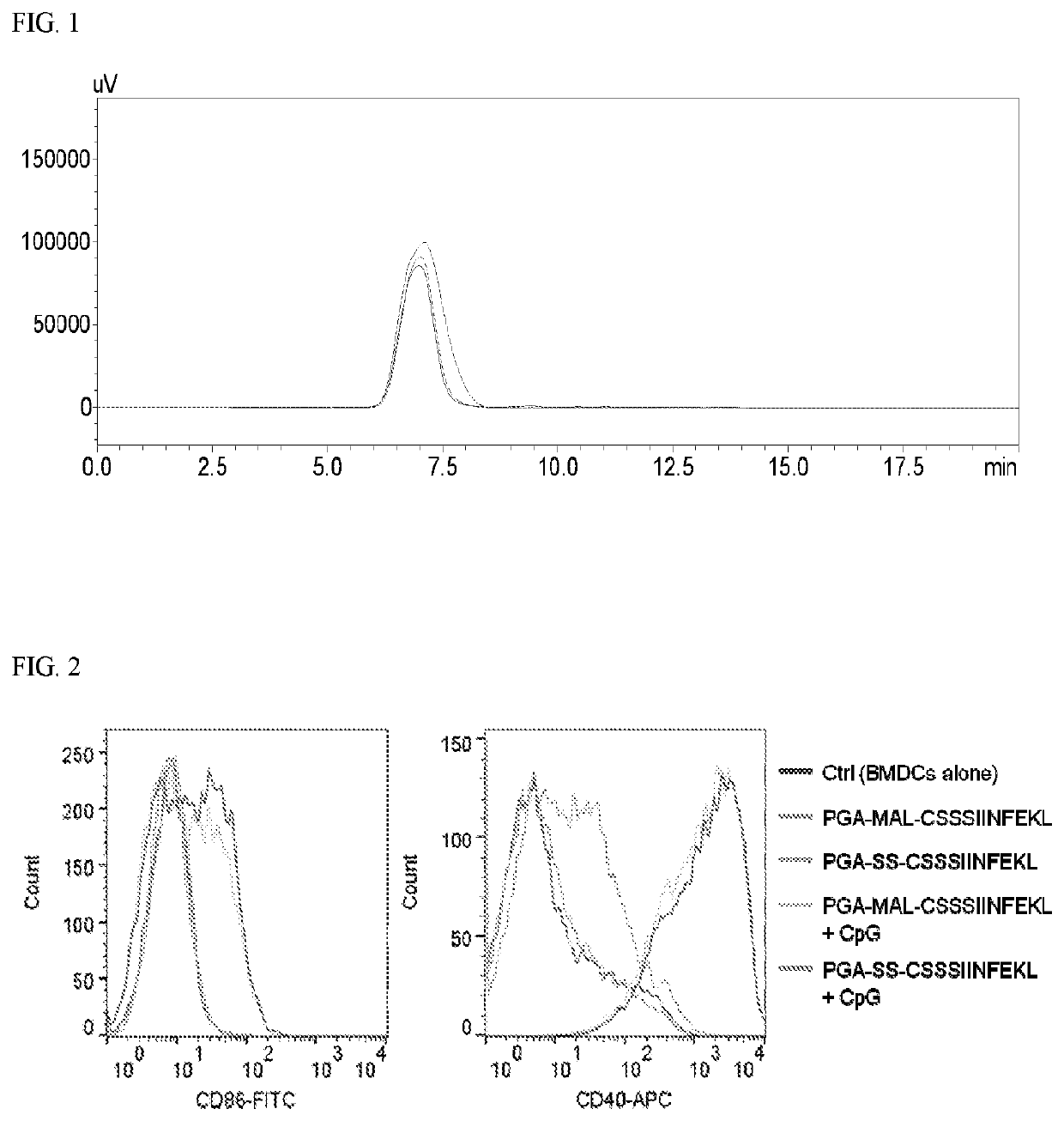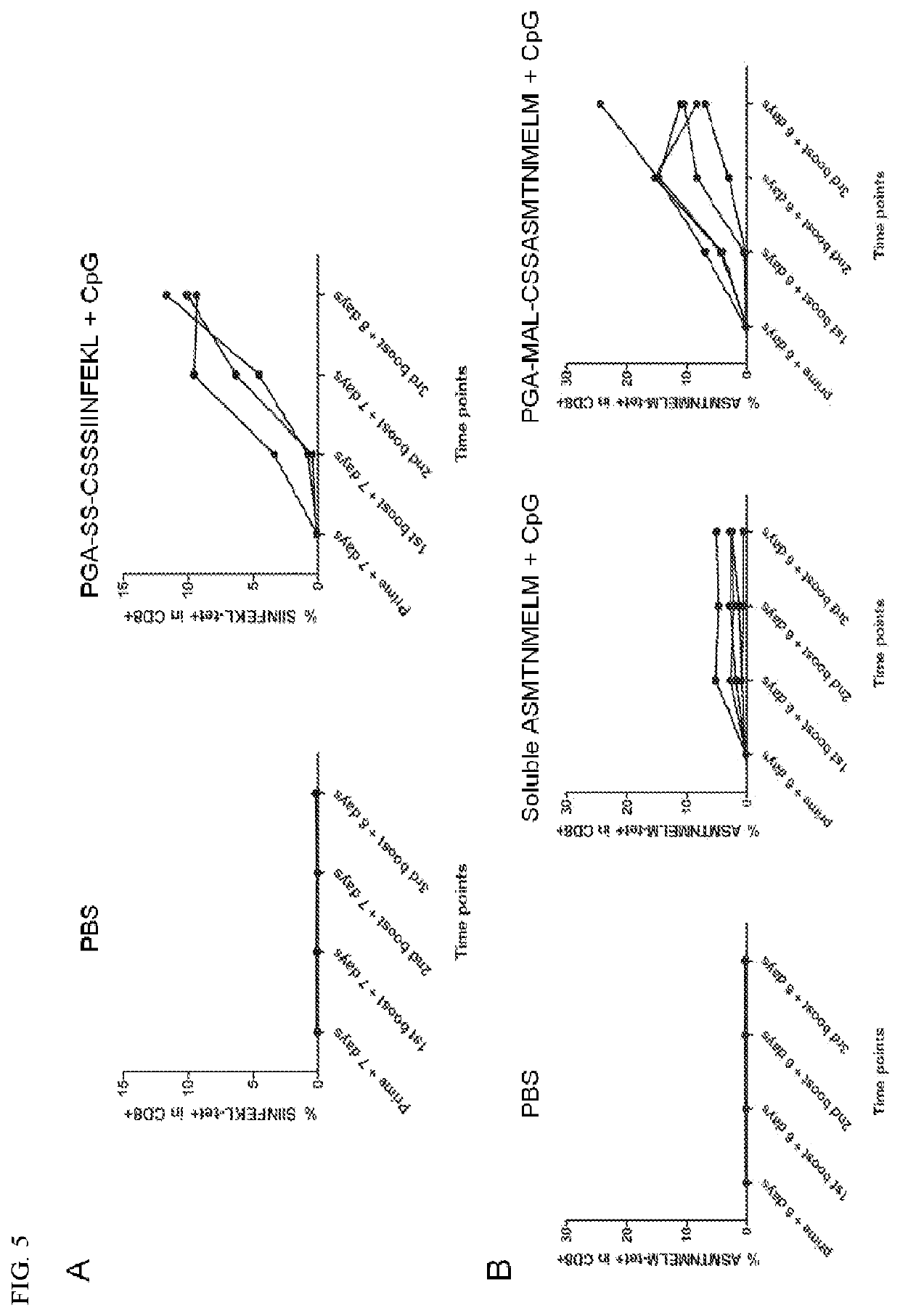Compositions and methods for delivery of polymer/biomacromolecule conjugates
a biomacromolecule and conjugate technology, applied in the field of polymer/biomacromolecule conjugate conjugate compositions and methods, can solve the problems of low immunogenicity of subunit antigens in vivo, low draining efficiency of oligopeptide antigens to lymphoid tissues, lymphoid draining, etc., to achieve stable pga-antigen conjugate, improve ag/adjuvant co-delivery, and maintain ag presentation
- Summary
- Abstract
- Description
- Claims
- Application Information
AI Technical Summary
Benefits of technology
Problems solved by technology
Method used
Image
Examples
example i
[0272]This example describes peptide antigens and tumor neo-antigens conjugated on poly(L-glutamic acid) polypeptides for vaccine delivery applications.
Materials
[0273]Poly-L-glutamic acid sodium salt (PGA, Mw 30 kD, 120 kD) was purchased from Alamanda Polymers (Huntsville, Ala.). N-(3-Dimethylaminopropyl)-N′-ethylcarbodiimide hydrochloride (EDC) and Dithiothreitol (DTT) were from Thermo Scientific (Waltham, Mass.). N-hydroxysuccinimide (NHS) and 4′,6-Diamidine-2′-phenylindole dihydrochloride (DAPI) were from Sigma-Aldrich (St. Louis, Mo.). N-(2-Aminoethyl)maleimide hydrochloride (MAL-NH2) and (S)-2-Pyridylthio cysteamine hydrochloride (PDP-NH2) were from TCI America (Portland, Oreg.) and Combi-Blocks (San Diego, Calif.), respectively. Antigen peptides including SIINFEKL, CSSSIINFEKL, CSSSIINFEKL-FITC, and ASMTNMELM, and murine GM-CSF were supplied by GenScript (Piscataway, N.J.). Peptide CSSASMTNMELM was synthesized by AnaSpec (Fremont, Calif.). The Toll-like receptor 9 agonist CpG ...
example ii
[0287]This example demonstrates that intratumoral delivery of PGA-peptide conjugates plus CpG eliminates MC38 tumors.
Methods
[0288]C57BL / 6 mice (n=5) were subcutaneously inoculated with 5×105 MC38 tumor cells on day 0, followed by a single intratumoral dose of soluble ASMTNMELM peptide or PGA120k-SS-CSSASMTNMELM (10 μg peptide / mouse), plus CpG (15 μg / mouse) on day 9, and the tetramer staining assay in PBMCs on days 16, 23, and 30. Tumor volumes were measured every three days and calculated as 0.5×[tumor length]×[tumor width]2.
Results
[0289]Therapeutic efficacy of the neo-antigen vaccine was tested on the MC38 tumor model. Compared to the admix of soluble peptide and CpG, a single intratumoral dose of PGA120k-SS-CSSASMTNMELM plus CpG elicited higher levels of antigen-specific CD8+ T cells, which were durable within 3 weeks after dosing (FIG. 7A), and regressed tumors in 80% of treated mice (FIG. 7B) with improved animal survival (FIG. 7C).
example iii
[0290]This example describes cancer immunotherapy with PEI-neo-antigen peptide conjugates.
Materials and Instruments
[0291]Polyethyleneimine (PEI, MW 25,000), dimethyl sulfoxide (DMSO), succinimidyl 3-(2-pyridyldithio)propionate (SPDP), 4′,6-Diamidine-2′-phenylindole dihydrochloride (DAPI) were purchased from Sigma-Aldrich. Methoxy poly(ethyleneglycol) propionic acid N-hydroxysuccinimide (MW 5,000, Methoxy-PEG-NHS) was purchased from Nanocs. Dithiothreitol (DTT) was obtained from Thermo Scientific. CpG (CpG 1826, 5′-tccatgacgttcctgacgtt-3′) was obtained from Integrated DNA Technology. Antigen peptide CSSASMTNMELM was supplied by RS synthesis. Antigen peptide ASMTNMELM and granulocyte-macrophage colony-stimulating factor (GM-CSF) were supplied by Genscript. RPMI 1640, penicillin-streptomycin (PS), beta-mercaptoethanol (b-ME), and ACK lysis buffer were obtained from Gibco. Fetal bovine serum (FBS) was obtained from Corning. Cell Counting Kit-8 (CCK-8) was purchased from Dojindo Laborato...
PUM
| Property | Measurement | Unit |
|---|---|---|
| molecular mass | aaaaa | aaaaa |
| pH | aaaaa | aaaaa |
| density | aaaaa | aaaaa |
Abstract
Description
Claims
Application Information
 Login to View More
Login to View More - R&D
- Intellectual Property
- Life Sciences
- Materials
- Tech Scout
- Unparalleled Data Quality
- Higher Quality Content
- 60% Fewer Hallucinations
Browse by: Latest US Patents, China's latest patents, Technical Efficacy Thesaurus, Application Domain, Technology Topic, Popular Technical Reports.
© 2025 PatSnap. All rights reserved.Legal|Privacy policy|Modern Slavery Act Transparency Statement|Sitemap|About US| Contact US: help@patsnap.com



